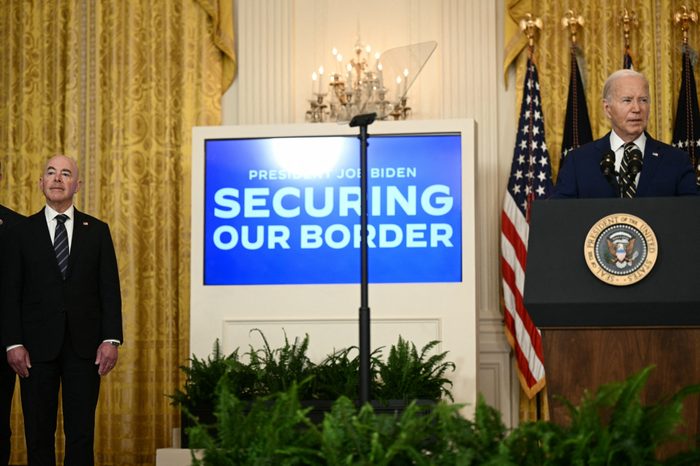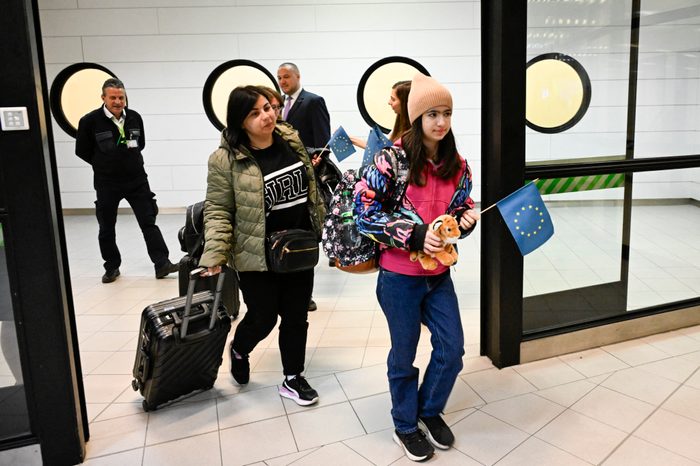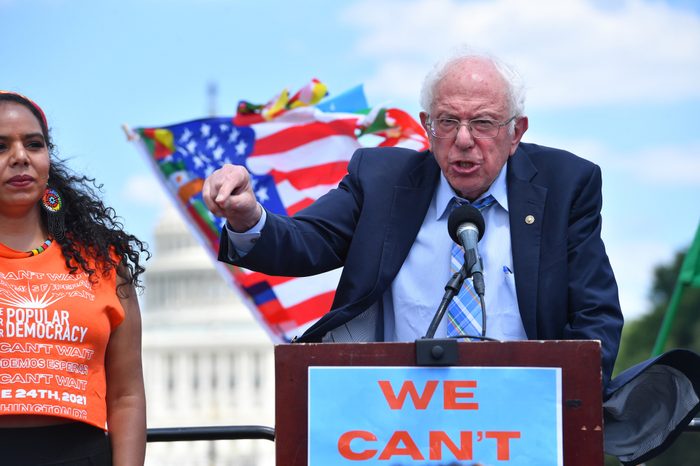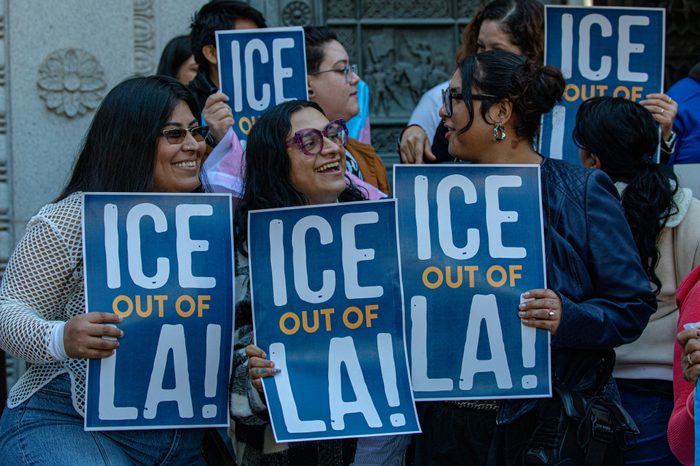Capital Has No Borders—Why Should We?
Precarious immigration status creates an exploitable labor force, allowing bosses to drive down wages for everyone. Inside the labor case for open borders.
Maurizio Guerrero

Elia Velásquez fled the violence and poverty that plagued her native El Salvador in the 1990s.
“I saw how my family was suffering, so I said to myself, ‘If I leave, I can work and help them,’ ” the 55-year-old hotel worker in Washington, D.C, tells In These Times during a phone interview in Spanish. “That would be better for them.”
El Salvador was deep into a fratricidal civil war, partially instigated and funded by the United States, that left the country in shambles when it ended in 1992.
Velásquez came to the United States and initially worked in a packaging facility in the Washington, D.C., area. There, workers did not even get “a glass of water” from the managers, she says. “We had rights to nothing.” Today, she still sees workers subjected to the same abuse — getting paid below the minimum wage while working in dangerous settings.
Many are forced into these conditions because they need to send money back to their native countries to support their families, as Velásquez did. “That’s exploitation,” says Velásquez. She had arrived in a country where immigrants are not only disproportionately vulnerable to workplace exploitation but also subject to increasingly hostile federal immigration policies.
In his book The Case for Open Borders, journalist John Washington writes that “corporations make millions off of migration, by exploiting migrant workers — harnessing borders to employ them at lower pay and offer them fewer labor protections.” All kinds of employers have benefitted from this system of abuse — facilitated by borders.
But opening the borders, only possible by federal action, may seem outlandish in the current political climate. Earlier this year, President Joe Biden signed into law the largest immigration enforcement budget, partly to keep an average of 41,500 immigrants per day locked up. Three months later, he effectively shut off asylum for the overwhelming majority of people arriving at the U.S.-Mexico border, contravening national and international standards. Despite this climate, we already have some insight into what open borders would be like for ordinary people thanks to local progressive immigration policies. And there are strong indications that protecting labor and civil rights regardless of immigration status has been a boon for the economy and a net positive for U.S. – born workers.

The rank and file of the labor movement has managed to adapt to the country’s changing demographics and increasingly protect workers regardless of immigration status. For many unions, it’s clear that protecting basic rights has been good for workers — citizens and non-citizens alike.
Take Velásquez’s case. After being mistreated at the packaging facility, she is now represented by UNITE HERE Local 25. “We are respected,” Velásquez says of her current workplace, “and treated as what we are: human beings.” She and her co-workers have access to food, water and lunch breaks, as well as medical insurance and a pension fund, similar to 7,500 hospitality industry workers in the more than 40 locations represented by UNITE HERE Local 25 in the D.C. area, regardless of immigration status.
Open borders, seemingly a pipe dream, have been a reality for wealthy individuals for centuries; U.S. citizens, for example, can travel without a visa to 189 countries. Several regions also share open borders. In the Schengen Area of the European Union, nearly half a billion people travel freely within 26 different countries. And in Mercosur, people from nine South American countries can work and reside anywhere within the area. Other regions in Africa, Asia and Oceania are similarly integrated.

But the vast majority of the world population is banned in the Global North. A growing number of cities, nonetheless, have created a network of borderless communities where solidarity among working-class people defies national boundaries — which, writes Harsha Walia in Border and Rule: Global Migration, Capitalism, and the Rise of Racist Nationalism, “manufacture divisions within the international working class.”
A lifeline for the U.S. economy
In the United States, free human mobility from Canada and Mexico was contemplated during the NAFTA trade agreement negotiations in the 1990s. But today, few discuss the possibility of opening the U.S. borders. Undocumented immigrants pay a very high price.
Non-citizen workers are more prone to suffering wage theft and injuries. Foreign-born Hispanic workers, for example, made up 8.2% of the U.S. workforce but 14.0% of work-related deaths in 2021. Some immigrants are detained for years in solitary confinement without any public justification, even after a court has ordered their removal. These mistreatments benefit from a national narrative that has consistently criminalized immigration.
Mainstream media has referred to the recent upsurge of migrants through the southern border as the “migrant crisis.” But while the U.S. immigrant population is growing, it’s doing so at a slower rate than a decade ago. Between 2021 and 2022, the immigrant population grew by 912,000 people—less than the 1 million it expanded from 2013 to 2014. Also, the share of immigrants in 2022 (13.9% of the U.S. population) is smaller than the 14.8% in 1890.
The new arrivals have been a lifeline for the U.S. economy, despite often being portrayed as “invaders” and “criminals.”
“Immigrants are not hurting U.S. workers,” says Daniel Costa, the director of immigration law and policy research at the Economic Policy Institute. “In fact, they’re helping in terms of job growth.” Their contributions are “one of the main reasons” the economy avoided a recession in 2023, says Costa. They are also critical for the future of the country.
The recent immigration surge will bolster the U.S. economy by about $7 trillion over the next decade by swelling the labor force and increasing demand, showed a Congressional Budget Office report from February. U.S. workers have benefitted.
As the unemployment rate for U.S.-born workers averaged 3.6% in 2023, the lowest on record, real per capita disposable income, adjusted for inflation, rose by 6% between the fourth quarters of both 2019 and 2023, according to the Center for Economic and Policy Research. Other studies show that immigration has also boosted wages for U.S.-born workers.
While unions and labor advocates have traditionally opposed high immigration because of the alleged downward pressure it puts on wages, that has started to change. For example, Senator Bernie Sanders (D-Vt.) warned for years that increased immigration would lower wages domestically. Now he suggests that immigrant and U.S.-born workers are pitted against each other and has advocated for protections against abusive employers and big business, as well as higher wages, better health care and access to higher education.

Last April, economists at the University of California, Davis concluded that from 2000 to 2019 immigration raised the wages of less educated native workers from 1.7 to 2.6% while having no significant effect on college-educated natives’ wages. Their study, published by the National Bureau of Economic Research, suggested immigrants also positively affected the wages of non-college natives from 2019 to 2022.
Despite the overall economic improvement, workers are still struggling. But “it’s not because immigrants are arriving,” Costa says. It’s because employers have taken advantage of the immigration status of the new arrivals.
The class-conscious ruling class exploits borders “to weaken collective bargaining rights and working-class resistance to transnational capital and its austerity measures,” writes Walia in her book. Take the case of 32-year-old Cristihan Adame, who was pushed to work up to 16-hour shifts in a car wash in Sacramento, Calif., after emigrating from Mexico in 2016. As an undocumented worker scared of being detained and deported, he had few options, he thought, and did not complain about the work conditions. “We always live with that fear [of deportation],” he tells In These Times in a phone interview in Spanish. Later, he got another job at a construction site in Las Vegas that offered no paid vacation or sick days. At this point, Adame realized he’d be better off in a union. His employers used all kinds of tactics to dissuade him from backing the unionization effort, he says, including threats to call immigration enforcement on him. The workers ultimately succeeded and a union was formed.
Undocumented immigrants are not the only non-citizens intimidated when trying to assert their rights. The H-2 visa guest worker programs infamously allow systematic abuse amid conditions akin to indentured servitude, as laborers are tied to a single employer. The same politicians who call for restricted immigration — often by criminalizing immigrants — support expanding the H-2 visa programs, which allow immigrants to temporarily work for agribusinesses and food industries such as meat and seafood processing. The number of H-2 visas has ballooned in recent years, but corporations have resisted improvements to the programs.
The U.S. Chamber of Commerce — “the world’s largest business organization”—objected to the updated H-2A visa labor rules proposed by the Department of Labor in April. The rules stress the rights of agriculture workers to advocate for better working conditions and receive union representatives. The Chamber claimed in the public comment portion of the rule-making process that the changes would introduce hiring delays and increase employers’ operating costs, thereby sticking American consumers with higher food prices. The Chamber did not respond to multiple requests for comment.
Despite the corporate efforts to maintain an exploitable underclass, the labor movement is expanding protections to immigrants and guest workers, in part, as a matter of strategy, considering that almost one in five workers in the country (18.6%) is not a U.S. citizen. The Farm Labor Organizing Committee (FLOC), associated with the AFL-CIO, has organized thousands of H-2A workers across North Carolina, similar to what the United Farm Workers (UFW) has done in California and recently in New York, where undocumented and H-2A laborers are pressing for union contracts.
“You simply cannot have a powerful and effective labor movement in the United States that doesn’t have a rock-solid backbone of immigrant workers,” says Benjy Cannon, spokesperson for UNITE HERE Local 25, in the D.C. area. “Labor is an immigrant rights issue and vice versa,” he says.

Building labor power with immigrant workers
In 2001, the largest federation of unions in the United States, the AFL-CIO, endorsed the right of all workers to organize regardless of their immigration status. Still, in March 2013, it demanded employers use an online tool called E-Verify to check the immigration status of workers if the program’s flaws were solved. Five months later, in a resolution introduced by the Alameda Labor Council (which includes San Francisco), the AFL-CIO flat-out rejected the use of E-Verify and still does. In response to a request for comment, Riley M. Lopez, the AFL-CIO national press secretary, clarified the federation’s “support for equal and enforceable rights for all workers, regardless of immigration status.”
Prodded by the bottom-up pressure of the labor movement, the AFL-CIO has “recentered immigration as a key issue of worker justice,” says Shannon Gleeson, a sociologist at the Cornell University School of Industrial and Labor Relations.
Some pro-immigrant policies are still resisted by key unions, notably those within the National Building Trade Federation, which did not respond to multiple requests for comment. However, protecting non-citizens is now central to many collective bargaining agreements, which can negotiate how an employer responds to immigration enforcement requests, whether or not to use E-Verify and whether to set up a legal fund to assist members in immigration courts, Gleeson says. For example, Laborers’ International Union of North America (LIUNA), a construction union with more than 500,000 members, has traditionally held immigrant rights at the top of its agenda.
SEIU has also been vocal about immigrant rights. “The problem with today’s economy is not immigrants; the problem is our broken immigration laws that allow big business to exploit workers who lack legal status,” wrote SEIU in 2021. If all workers enjoyed equal rights, the union stated, it would be possible to “eliminate the two-tiered workforce and build a united labor movement that raises wages and living standards for all workers.”
The transversal solidarity within the labor movement, along with progressive jurisdictions’ policies, has produced a potent mix that has expanded immigrant rights in the United States. Community organizations, faith-based institutions and, to a lesser extent, philanthropic foundations, have pressured cities to adopt integration policies for immigrants — creating what scholars have termed urban citizenship, says Els de Graauw, a migration and urban public policy scholar at the City University of New York (CUNY). Urban citizenship gives insight into what open borders would look like in the United States.
Millions of immigrants have become “citizens” of San Francisco, New York and Chicago — where urban citizenship is more consolidated, says de Graauw. They have been able to access free or low-cost healthcare, I.D.s and driver’s licenses, services in their language and higher-education financial aid, among other rights and benefits.

And in more than 200 jurisdictions across the country, undocumented immigrants are protected by sanctuary policies. Many of these sanctuary cities only cooperate with federal immigration agents if they show a criminal warrant when targeting someone for deportation. And some 50 jurisdictions across 21 states, including Los Angeles, San Francisco and Chicago, offer legal representation to individuals in deportation proceedings at little to no cost.
We are seeing the creation of a network of cities and industries in which basic human rights do not depend on a person’s passport — a world in which crossing a border does not annul one’s humanity.
Consider We Rise SF, founded nine years ago as the immigration legal center for the AFL-CIO’s San Francisco Labor Council. Partially funded by the city and the state of California, it assists the undocumented laborers among its 100,000 council members — 40 to 50% of them non-citizens, according to Tom Ryan, the legal center’s executive director.
During the pandemic, We Rise SF distributed $500,000 to members excluded from federal unemployment benefits or stimulus checks due to their immigration status. “It was a watershed moment for the council,” says Ryan, as the local labor leadership recognized that a significant number of members needed special support.
During the pandemic, California also provided financial support to undocumented immigrants. Meanwhile in 2020, Make the Road New York, the largest grassroots immigrant-led organization in the state, spearheaded a campaign that lasted about two years and involved weeks-long hunger strikes by several of their members. They pressured then Governor Andrew Cuomo to create a $2.1 billion fund for workers excluded from federal support. The grassroots campaign in New York inspired similar efforts in New Jersey and Washington.
Despite the toxic rhetoric around the border and the increasingly restrictive federal immigration policies, workers like Adame are now full citizens of the cities they reside in. Urban citizenship has grown strong partly due to the fragmentation within federal regulations, says the scholar de Graauw: While DHS approaches immigration as a security issue, she says, labor standards are intended for all workers.
A taste of a borderless world is possible even in Republican states with few progressive jurisdictions and labor policies. Worker-driven social responsibility, a framework pioneered by the Coalition of Immokalee Workers in Florida, promotes legally binding contracts among workers, farmers and retail buyers. It has successfully raised wages and improved workplace standards for thousands of farmworkers. The coalition’s model has been replicated by the Milk with Dignity campaign in Vermont’s dairy industry, the Building Dignity and Respect Program in Minnesota’s construction industry and the Venceremos campaign for poultry workers in Arkansas.
The victories for workers’ rights, especially encouraging considering the aggressive immigration enforcement policies of the Biden administration, would be seriously challenged by a second Trump administration, as it plans to severely curtail immigration and execute deportations en mass. This nativist agenda would further divide the working class and substantially hobble the country’s economy, as declining birth rates, reduced net migration and aging demographics could eventually slow population growth in the United States. Without immigrants, the country’s population would start declining within a year, the U.S. Census Bureau projects.
Closed borders only benefit the elites. Treating migrants as commodities, exploiting their labor and paying them as little as possible, argues Washington in his book, are the principal drivers for closed borders.
However, in many U.S. streets and workplaces, spaces where it’s clear that “a strong and integrated and diverse labor movement is the key to the future of the United States,” says Cannon from UNITE HERE Local 25, a world with open borders seems possible.
Maurizio Guerrero is a journalist based in New York City. He covers migration, social justice movements and Latin America.











